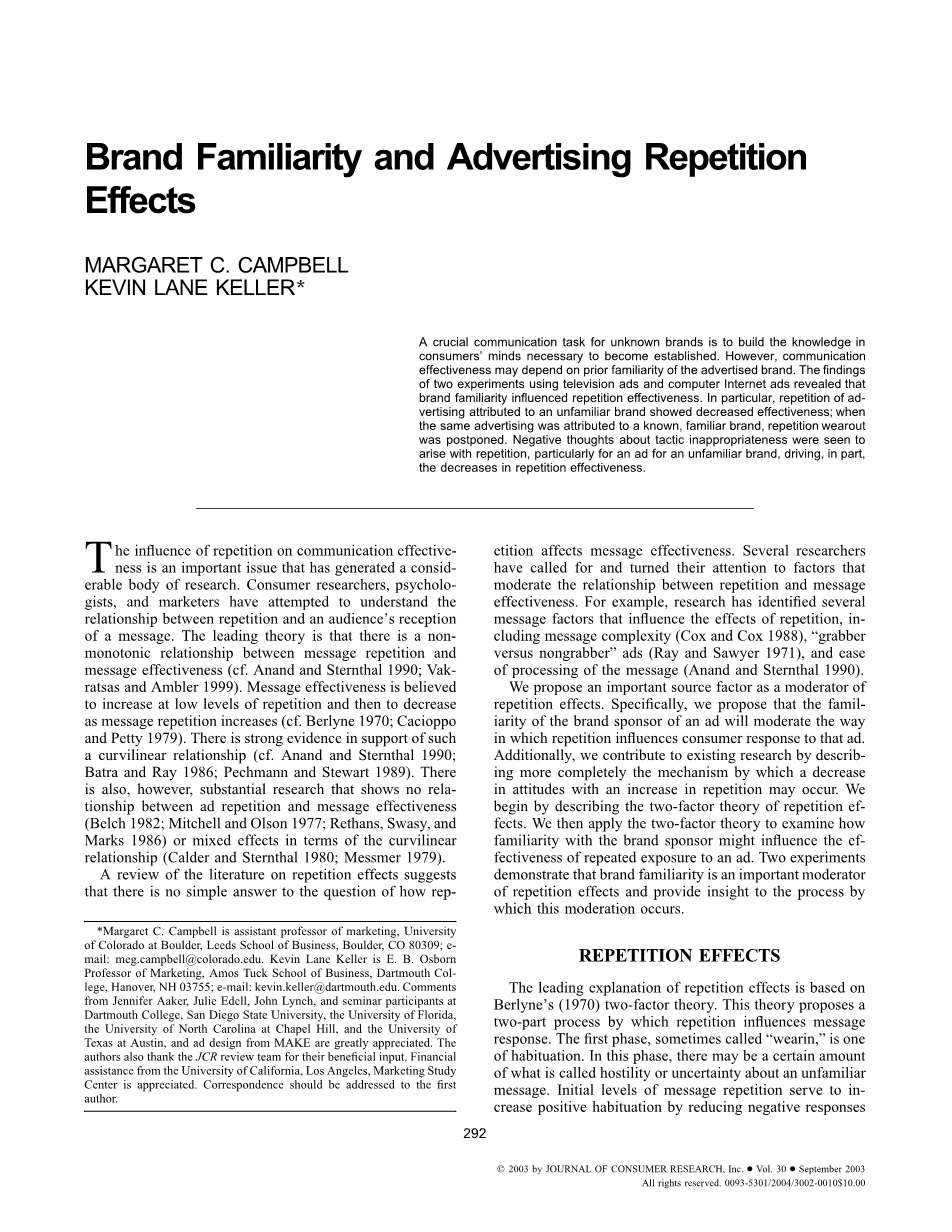

英语原文共 14 页,剩余内容已隐藏,支付完成后下载完整资料
Brand Familiarity and Advertising Repetition Effects
MARGARET C. CAMPBELL
KEVIN LANE KELLER
A crucial communication task for unknown brands is to build the knowledge in consumersrsquo; minds necessary to become established. However, communication effectiveness may depend on prior familiarity of the advertised brand. The findings of two experiments using television ads and computer Internet ads revealed that brand familiarity influenced repetition effectiveness. In particular, repetition of ad-vertising attributed to an unfamiliar brand showed decreased effectiveness; when the same advertising was attributed to a known, familiar brand, repetition wearout was postponed. Negative thoughts about tactic inappropriateness were seen to arise with repetition, particularly for an ad for an unfamiliar brand, driving, in part, the decreases in repetition effectiveness.
The influence of repetition on communication effectiveness is an important issue that has generated a consid-erable body of research. Consumer researchers, psychologists, and marketers have attempted to understand the relationship between repetition and an audiencersquo;s reception of a message. The leading theory is that there is a non-monotonic relationship between message repetition and message effectiveness (cf. Anand and Sternthal 1990; Vak-ratsas and Ambler 1999). Message effectiveness is believed to increase at low levels of repetition and then to decrease as message repetition increases (cf. Berlyne 1970; Cacioppo and Petty 1979). There is strong evidence in support of such a curvilinear relationship (cf. Anand and Sternthal 1990; Batra and Ray 1986; Pechmann and Stewart 1989). There is also, however, substantial research that shows no relationship between ad repetition and message effectiveness (Belch 1982; Mitchell and Olson 1977; Rethans, Swasy, and Marks 1986) or mixed effects in terms of the curvilinear relationship (Calder and Sternthal 1980; Messmer 1979). A review of the literature on repetition effects suggests that there is no simple answer to the question of how repetition affects message effectiveness. Several researchers have called for and turned their attention to factors that moderate the relationship between repetition and message effectiveness. For example, research has identified several message factors that influence the effects of repetition, including message complexity (Cox and Cox 1988), “grabber versus nongrabber” ads (Ray and Sawyer 1971), and ease of processing of the message (Anand and Sternthal 1990).
We propose an important source factor as a moderator of repetition effects. Specifically, we propose that the familiarity of the brand sponsor of an ad will moderate the way in which repetition influences consumer response to that ad. Additionally, we contribute to existing research by describing more completely the mechanism by which a decrease in attitudes with an increase in repetition may occur. We begin by describing the two-factor theory of repetition effects. We then apply the two-factor theory to examine how familiarity with the brand sponsor might influence the effectiveness of repeated exposure to an ad. Two experiments demonstrate that brand familiarity is an important moderator of repetition effects and provide insight to the process by which this moderation occurs.
REPETITION EFFECTS
The leading explanation of repetition effects is based on Berlynersquo;s (1970) two-factor theory. This theory proposes a two-part process by which repetition influences message response. The first phase, sometimes called “wearin,” is one of habituation. In this phase, there may be a certain amount of what is called hostility or uncertainty about an unfamiliar message. Initial levels of message repetition serve to in-crease positive habituation by reducing negative responses to the novel stimulus, thus increasing effectiveness at lower levels of repetition (Cox and Cox 1988). The second phase, sometimes called “wearout,” is when continued repetition results in the onset of tedium such that the message decreases in effectiveness (Anand and Sternthal 1990; Blair and Ra-buck 1998; Calder and Sternthal 1980). Tedium arises be-cause of boredom, less opportunity to learn, and reactance against the repeated message.
Two important conceptual contributions have been made to the two-factor theory of repetition effects. First, Cacioppo and Petty (1979) examined the processing and memory effects underlying Berlynersquo;s theorizing. They demonstrated that cognitive responses to the message appear to mediate the effects of repetition on the overall evaluations engendered by an ad: support arguments first increase and then decrease with repetition; counterarguments, by contrast, may first decrease and then increase with repetition. Cacioppo and Petty (1979) show that repetition has its greatest effect at moderate levels of repetition. It appears that under low levels of repetition resources are not sufficient for complete processing but that high levels of repetition prompt counterargumentation. Second, Anand and Sternthal (1990) show that, in addition to the important effects of resource avail-ability, resource requirements for processing influence the effect of repetition. They show that the ease of processing moderates the influence of repetition on brand attitude. Greater processing difficulty slows the habituation and tedium experienced by the consumer so that the point at which ad wearout occurs is delayed, while low processing difficulty speeds up the point at which wearout occurs. Anand and Sternthal (1990) conclude that both resource availability and resource requirements influence when repetition effects will be greatest.
Brand Familiarity
We draw on this theorizing to propose that brand familiarity is an important variable that can influence consumer processing and the stag
全文共73588字,剩余内容已隐藏,支付完成后下载完整资料
资料编号:[451985],资料为PDF文档或Word文档,PDF文档可免费转换为Word


